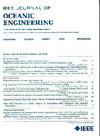A Robust Sidescan Sonar Bottom-Tracking Method Based on an Adaptive Threshold
IF 5.3
2区 工程技术
Q1 ENGINEERING, CIVIL
引用次数: 0
Abstract
Bottom tracking is an essential step in sidescan sonar image processing, which plays a crucial role in geometric distortion correction, geocoding, and image stitching. However, it is difficult to achieve accurate and automatic bottom tracking due to the influence of reflected surface echoes or suspensions in water. Therefore, this article proposes a robust and automatic bottom-tracking method considering multiple influencing factors. First, the bottom-tracking range is delineated by determining whether there are surface echoes. Then, the intensity difference between adjacent sampling intervals of the sonar image is calculated and bottom tracking is performed by an adaptive threshold. Finally, the bottom-tracking results are smoothed by combining them with the robust linear regression algorithm. Experimental results show that the detection accuracy of the proposed method is above 95%, which is higher than the results of the conventional threshold method (79.3%), Laplacian of Gaussain (LOG) operator (77.0%), and Canny operator (87.0%). The proposed method can adaptively adjust the threshold parameters and has a better bottom-tracking result with less computational complexity.一种基于自适应阈值的稳健侧扫声纳底部跟踪方法
底部跟踪是侧扫声纳图像处理的关键步骤,在几何畸变校正、地理编码和图像拼接等方面起着至关重要的作用。然而,由于水面反射回波或水中悬浮物的影响,难以实现准确、自动的海底跟踪。因此,本文提出了一种考虑多种影响因素的鲁棒自动底部跟踪方法。首先,通过确定是否有地面回波来划定底部跟踪范围。然后,计算声纳图像相邻采样间隔的强度差,采用自适应阈值进行底部跟踪;最后,结合鲁棒线性回归算法对底部跟踪结果进行平滑处理。实验结果表明,该方法的检测准确率在95%以上,高于传统阈值法(79.3%)、拉普拉斯-高斯(LOG)算子(77.0%)和Canny算子(87.0%)的结果。该方法可以自适应调整阈值参数,具有较好的底部跟踪效果,且计算复杂度较低。
本文章由计算机程序翻译,如有差异,请以英文原文为准。
求助全文
约1分钟内获得全文
求助全文
来源期刊

IEEE Journal of Oceanic Engineering
工程技术-工程:大洋
CiteScore
9.60
自引率
12.20%
发文量
86
审稿时长
12 months
期刊介绍:
The IEEE Journal of Oceanic Engineering (ISSN 0364-9059) is the online-only quarterly publication of the IEEE Oceanic Engineering Society (IEEE OES). The scope of the Journal is the field of interest of the IEEE OES, which encompasses all aspects of science, engineering, and technology that address research, development, and operations pertaining to all bodies of water. This includes the creation of new capabilities and technologies from concept design through prototypes, testing, and operational systems to sense, explore, understand, develop, use, and responsibly manage natural resources.
 求助内容:
求助内容: 应助结果提醒方式:
应助结果提醒方式:


